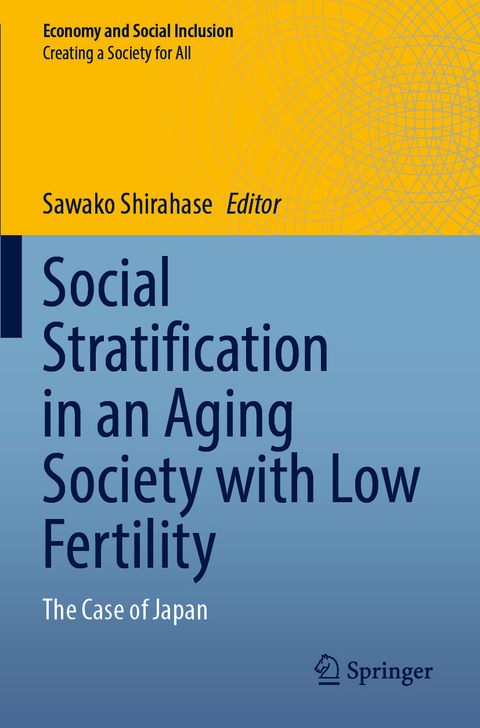
Social Stratification in an Aging Society with Low Fertility
Springer Verlag, Singapore
978-981-19-3649-4 (ISBN)
Japan experienced a dramatic change in its demographic structure in a short period of time. Such fast change could be a major factor that generated social stratification. In her industrialization, Japan was thought to share a pattern of social stratification similar to that of developed European and North American countries but with a low degree of socio-economic inequality and a high degree of homogeneity. There is no clear support for this description of Japan, although the country does share a pattern and degree of social stratification similar to that observed in Europe and North America.
The social stratification theory has been developed in close relationship to the labor market; however, it is necessary to further examine the social stratification of very aged societies in which a substantial number of the population—namely, retired persons—no longer have any ties to the labor market. In this book, the contributors explore the pattern of social stratification at three life stages: young, middle-aged, and elderly. Included are discussions of various aspects of stratification such as education, work, wealth, marriage, family, gender, generation, and social attitudes.
Sawako Shirahase is Professor of Sociology at the Graduate School of Humanities and Sociology, the University of Tokyo. She received her D.Phil. in sociology from the University of Oxford, conducted post-doctoral research at the East Asian Institute, Columbia University as a junior researcher, and held positions of Senior Research fellow at the National Institute of Population and Social Security Research, and Associate Professor of Sociology at Tsukuba University. She is currently a director of the UTokyo Center for Contemporary Japanese Studies. Dr. Shirahase’s research interests include comparative social stratification and demographic transformation, gender and generational relations, and family change and social security system. She is the author of Social Inequality in Japan (Routledge, 2014) and Demographic Change and Inequality in Japan (ed.) (Trans Pacific Press, 2011), and her recent publications are “Social Stratification Theory and PopulationAging Reconsidered,” (Social Science Japan Journal 24(2): 277–288, 2021) and The Structure of Social Stratification in the Late-stage of Life (in Japanese) (ed., with S. Arita and N. Sudo) (University of Tokyo Press, 2021). Dr. Shirahase is on the editorial board of International Sociology and Contemporary Japan, and on the advisory board of Social Politics. She currently serves as Vice President of the International Sociological Association and Vice President of the International Science Council. She was the principal investigator of the research project conducting the 2015 National Survey of Social Stratification and Social Mobility (SSM) Survey which has been conducted every 10 years since 1955.
Chapter 1 Class Structure, Education, and Social Mobility in Post-war Japan.- Chapter 2 The changing marriage market and status homogamy.- Chapter 3 Relative Indices of Educational Attainment and Trend Analysis of Inequality of Educational Opportunity Using the 2015 SSM Survey Data.- Chapter 4 Long-Term Trends in Long-Term Employment in Japan.- Chapter 5 Intragenerational Mobility between Regular and Non-regular Employment Sectors in Japan: From the Viewpoint of the Theory of Mobility Regime.- Chapter 6 Gap in Attitudes toward Higher Education between Graduates and Non-graduates: Growing Educational Disparity in Younger Cohorts.- Chapter 7 Effects of Regional Inequality on Political Attitudes: Social Capital and Support for Redistribution and Free Competition.- Chapter 8 Explanation of Socioeconomic Inequality among the Male Elderly: An Approach Based on Estimated Income History.- Chapter 9 Another aspect of social inequality, wealth, in a super-aged society, Japan: Re-examining the conventional framework of social stratification.
| Erscheinungsdatum | 06.09.2023 |
|---|---|
| Reihe/Serie | Economy and Social Inclusion |
| Zusatzinfo | 5 Illustrations, color; 34 Illustrations, black and white; IX, 214 p. 39 illus., 5 illus. in color. |
| Verlagsort | Singapore |
| Sprache | englisch |
| Maße | 155 x 235 mm |
| Themenwelt | Sozialwissenschaften ► Soziologie ► Makrosoziologie |
| Sozialwissenschaften ► Soziologie ► Mikrosoziologie | |
| Wirtschaft ► Allgemeines / Lexika | |
| Wirtschaft ► Volkswirtschaftslehre ► Mikroökonomie | |
| Schlagworte | Aging Population • Educational attainment • Job insecurity in work life • Low fertility • Social Stratification • Wealth Inequality |
| ISBN-10 | 981-19-3649-8 / 9811936498 |
| ISBN-13 | 978-981-19-3649-4 / 9789811936494 |
| Zustand | Neuware |
| Informationen gemäß Produktsicherheitsverordnung (GPSR) | |
| Haben Sie eine Frage zum Produkt? |
aus dem Bereich


